What types of activities can the teachers at Washington Elementary use to increase their students’ reading skills?
Page 4: PALS Activities for First-Grade Students
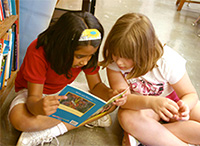 The first-grade teachers at Washington Elementary are excited to learn that PALS for first-grade is highly structured: The lessons are sequential, and the skills learned are cumulative. Additionally, it picks up where K-PALS leaves off. More specifically, PALS for first grade helps students to:
The first-grade teachers at Washington Elementary are excited to learn that PALS for first-grade is highly structured: The lessons are sequential, and the skills learned are cumulative. Additionally, it picks up where K-PALS leaves off. More specifically, PALS for first grade helps students to:
- Decode and comprehend text
- Read more fluently
- Perform better on standardized and informal reading tests
Research Shows
- PALS can improve the fluency and comprehension skills of first-grade students.
(Fuchs and Fuchs, 2005) - Students participating in first-grade PALS experience greater growth in reading performance than do students who receive traditional classroom instruction.
(Calhoon, Al Otaiba, Greenberg, King, & Avalos, 2006)
First-Grade PALS Activities
First-grade PALS sessions typically last about 40 minutes and are conducted at least three times per week. The sessions begin with approximately five minutes of whole-group instruction during which the teacher introduces new sounds, sight words, and vocabulary words (i.e., rocket words) and conducts a segmenting and blending activity.
rocket words
Vocabulary words embedded in first-grade PALS stories as a means of increasing students’ interest in those stories. Examples of rocket words for first-grade students are “fuzzy” (beginning of the year), “birthday party” (mid-year), and “marshmallows” (end of the year).
Following this brief introduction, peer pairs work on two main activities: Sounds and Words and Partner Reading. The table below highlights the reading games or tasks for each activity and the skills they address. Click on the links to learn more about each game.
 Activities Activities |
 Skills Skills |
 Games and Tasks Games and Tasks |
Sound and Words21 minutes |
Phonological Awareness and Decoding | |
|
Saying Sounds Skill: Letter-sound correspondence Time: 3 minutes Implementation Procedure: In each lesson, the new sound or sounds appear inside boxes. The Coach points to each letter and asks, “What sound?” The Reader responds.
Corrective Feedback Procedure: If the Reader makes a mistake, the Coach corrects the error by saying, “Stop. That sound is __. What sound?” After the Reader responds with the correct answer, the Coach says, “Start the line again.” (Close this panel) Sounding Out Skill: Blending Time: 5 minutes Implementation Procedure: With each word in the lesson, the Coach prompts the Reader to “Sound it out.” The Reader does so, and the Coach says, “Read it fast.” Note: Each lesson contains eight to ten words that the teacher introduced during the whole group blending and segmenting activity.
Corrective Feedback Procedure: If the Reader makes a mistake, the Coach corrects the error by saying, “Stop. That word is ______ (sounds out word). ______ (reads word quickly). Sound it out. Read it fast.” Once the Reader sounds it out, the Coach says, (Close this panel) Sight Words Skill: Sight word recognition Time: 4 minutes Implementation Procedure: During each lesson, the Coach points to the first word and says, “Read the words.” The Reader responds. Note: Beginning with Lesson 20, sight words are grouped into short phrases in order to promote fluency.
Corrective Feedback Procedure: If the Reader makes a mistake, the Coach corrects the error by saying, “Stop. That word is ______. What word?” The Reader pronounces the word, and the Coach says, (Close this panel) Stories Skill: Decoding and sight word recognition Time: 5 minutes Implementation Procedure: Once the teacher has introduced new and reviewed the previously introduced rocket words, he or she models how to read the story quickly and correctly while the students follow along on their lesson sheets. The Coach then prompts the Reader to “Read the story.”
Corrective Feedback Procedure:
(Close this panel) Speed Game Skill: Fluency and Word Recognition Time: 6 minutes
Corrective Feedback Procedure:
(Close this panel) |
||
Partner Reading10 minutes |
Fluency and Word Recognition | |
|
Reading Books Skill: Fluency and word recognition Time: 10 minutes
Note: Partner Reading is introduced around week 10 (i.e., Lesson 30). Corrective Feedback Procedure:
(Close this panel) |
||
Devin Kearns explains that the first-grade PALS program—while introducing students to advanced skills—begins with simple, easily implemented activities (time: 0:55).

Transcript: Devin Kearns, MA
The first-grade program does actually move very quickly, like the kindergarten program. Again, we find that students are really able to handle all the first-grade material. It’s a challenging curriculum, but students respond to it. They get very excited about it because by the thirtieth lesson they are actually reading books, and they are introduced to reading books outside the program. So it’s a very effective program. The first-grade program includes a way to introduce students to activities over time, and so they begin with very simple activities naming letter sounds, and then they do sight words, and then they do reading words. They build the activities over a number of different lessons, and by the end of the year the students are reading paragraphs and in addition reading stories in pairs. It builds in a way that makes it possible for the students to do it, and by the end of the year they’re great readers who can read text on their own.
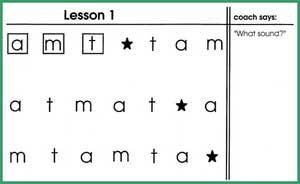 Example: In the example to the right, the Coach begins by pointing to the letter “a” and asks, “What sound?” The Reader says /a/.
Example: In the example to the right, the Coach begins by pointing to the letter “a” and asks, “What sound?” The Reader says /a/.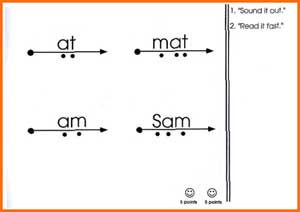 Example: In this example, the Coach says, “Sound it out,” and the Reader says /a/ /t/. The Coach then says, “Read it fast.” The Reader says “at.”
Example: In this example, the Coach says, “Sound it out,” and the Reader says /a/ /t/. The Coach then says, “Read it fast.” The Reader says “at.”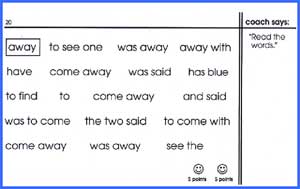 Example: In this example, the Coach points to the phrase “to see one” and says, “Read the words.” The Reader says the phrase and continues until all phrases have been read.
Example: In this example, the Coach points to the phrase “to see one” and says, “Read the words.” The Reader says the phrase and continues until all phrases have been read.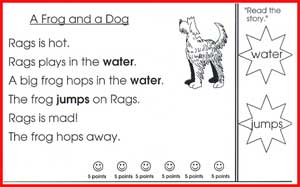 Example: In this example, two rocket words appear on the right side of the page. The Coach says, “Read the story,” and the Reader begins by reading the title then proceeds through the entire story.
Example: In this example, two rocket words appear on the right side of the page. The Coach says, “Read the story,” and the Reader begins by reading the title then proceeds through the entire story.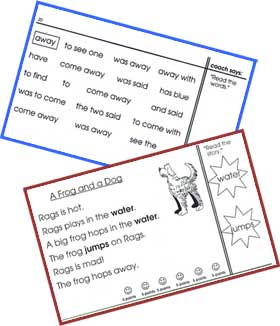 Implementation Procedure: At the end of each Sounds and Words lesson, each student reads the same word list or story three times, always starting at the same place. For approximately the first half of the lessons, the students read sight words and have 30 seconds to complete each trial. Later in the year, the students read stories, still having 30 seconds to complete each trial. The students’ goal during the second and third trials is to increase the number of words read.
Implementation Procedure: At the end of each Sounds and Words lesson, each student reads the same word list or story three times, always starting at the same place. For approximately the first half of the lessons, the students read sight words and have 30 seconds to complete each trial. Later in the year, the students read stories, still having 30 seconds to complete each trial. The students’ goal during the second and third trials is to increase the number of words read. Implementation Procedure: Using a book provided by the teacher, the Coach begins to read, pointing to each word as he does so. Next, the Reader reads the same page. Once the pair has completed the book, they switch roles. After each member of the dyad has read the book two times (four times, total, per dyad), the teacher gives them a new book.
Implementation Procedure: Using a book provided by the teacher, the Coach begins to read, pointing to each word as he does so. Next, the Reader reads the same page. Once the pair has completed the book, they switch roles. After each member of the dyad has read the book two times (four times, total, per dyad), the teacher gives them a new book.